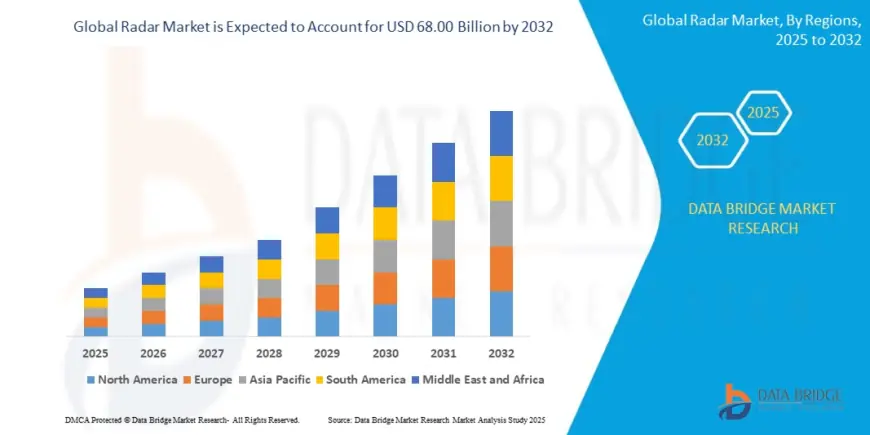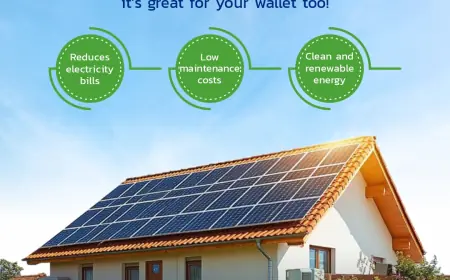Radar Market Industry Statistics: Growth, Share, Value, Insights, and Trends

Introduction
Radar technology, an acronym for Radio Detection and Ranging, has become an indispensable tool across various sectors, from defense to automotive industries. Its ability to detect objects, determine their position, and track their movement has revolutionized how we perceive and interact with our environment. As we delve into the radar market, it's evident that this technology continues to evolve, driven by technological innovations and expanding applications.
Historical Evolution of Radar Technology
The inception of radar dates back to World War II, where it played a crucial role in military operations, enabling forces to detect enemy aircraft and ships beyond visual range. Post-war, radar technology transitioned into civilian applications, including air traffic control and weather monitoring. This diversification marked the beginning of radar's pervasive presence in both military and civilian domains.
Current Market Overview
The global radar market has witnessed substantial growth over the years. In 2024, the market was valued at approximately USD 37.64 billion and is projected to reach nearly USD 54.13 billion by 2034, growing at a compound annual growth rate (CAGR) of 3.70% between 2025 and 2034 . This growth is attributed to the increasing demand for radar systems in defense, aerospace, and automotive sectors. Key industry players such as Raytheon Technologies, Lockheed Martin, and Northrop Grumman dominate the market, contributing significantly to its expansion.
Technological Innovations Driving the Market
Advancements in signal processing have enhanced radar resolution and accuracy, enabling more precise detection and tracking capabilities. The integration of artificial intelligence (AI) and machine learning (ML) has further revolutionized radar systems, allowing for adaptive learning and improved target recognition. These technological strides have expanded radar applications, making them more efficient and reliable across various industries.
Segmentation of the Radar Market
The radar market is segmented based on type and application. By type, it includes Pulse radar and Continuous Wave radar, each serving distinct purposes. Applications span across defense, commercial, automotive, and meteorological sectors, reflecting the versatility of radar technology in addressing diverse operational needs.
Defense and Military Applications
In defense, radar systems are pivotal for surveillance, reconnaissance, and missile defense. They provide real-time information on potential threats, enhancing situational awareness and strategic decision-making. The continuous evolution of radar technology ensures that military forces maintain a tactical advantage in various operational scenarios.
Automotive Radar Systems
The automotive industry has embraced radar technology to enhance vehicle safety and pave the way for autonomous driving. Radar systems are integral to Advanced Driver Assistance Systems (ADAS), facilitating features like adaptive cruise control and collision avoidance. As the industry moves towards higher levels of vehicle autonomy, the demand for sophisticated radar systems is expected to surge.
Aerospace and Air Traffic Control
In aviation, radar systems are essential for ensuring flight safety and efficient air traffic management. They monitor aircraft positions, assist in navigation, and manage airport surface movements, thereby reducing the risk of collisions and enhancing operational efficiency in increasingly congested airspaces.
Maritime and Naval Applications
Radar technology is crucial in maritime operations for ship navigation, collision avoidance, and coastal surveillance. It enables vessels to detect obstacles, monitor maritime traffic, and ensure safe passage through challenging environments, thereby safeguarding lives and cargo.
Meteorological and Environmental Monitoring
Meteorologists rely on radar systems for weather prediction and storm tracking. Radar provides detailed information on precipitation patterns, storm intensity, and movement, aiding in timely warnings and disaster preparedness. Additionally, radar contributes to climate research by monitoring environmental changes over time.
Regional Market Analysis
-
North America: The region leads in technological advancements and defense spending, driving substantial demand for radar systems. The presence of major defense contractors further bolsters market growth.
-
Europe: Collaborative defense projects and stringent regulations have fostered a robust radar market. European nations invest in joint ventures to develop advanced radar technologies, enhancing their defense capabilities.
-
Asia-Pacific: Rapid industrialization and defense modernization efforts, particularly in countries like China and India, have escalated the demand for radar systems. The region is projected to witness the fastest CAGR from 2024 to 2030 .
-
Rest of the World: Emerging markets in Latin America and Africa present new opportunities for radar applications, driven by economic development and increasing security concerns.
Market Drivers
Several factors propel the radar market forward:
-
Increasing Defense Budgets: Nations worldwide are augmenting their defense expenditures, leading to heightened procurement of advanced radar systems for national security.
-
Automotive Safety Demand: The rising emphasis on vehicle safety and the push towards autonomous vehicles have spurred the integration of radar systems in automotive designs.
-
Air Traffic Growth: The expansion of global air travel necessitates efficient air traffic management, thereby increasing the reliance on radar systems for safe and orderly operations.
Market Challenges
Despite the growth, the radar market faces challenges:
-
High Costs: The development and maintenance of advanced radar systems involve significant investment, posing financial challenges for some organizations.
-
Regulatory Issues: Spectrum allocation and regulatory compliance can impede the deployment and operation of radar systems, especially in densely populated regions.
-
Technological Complexities: Integrating radar systems with other technologies requires sophisticated engineering, which can be a barrier for
-
Technological Complexities: Integrating radar systems with other technologies requires sophisticated engineering, which can be a barrier for some industries. Compatibility issues and the need for specialized expertise further add to the complexity.
-
Environmental Limitations: Weather conditions, terrain, and electromagnetic interference can impact radar performance. Developers must continuously innovate to mitigate these challenges.
Future Outlook and Opportunities
The radar market is set for continuous evolution, driven by emerging technologies and increasing demand across various sectors. Here’s what the future holds:
Emerging Markets and Untapped Potential
Countries in South America, Africa, and Southeast Asia are witnessing increased defense spending and infrastructure development, creating lucrative opportunities for radar manufacturers. These regions are also investing in air traffic management, meteorological monitoring, and maritime security, further fueling market expansion.
Integration with 5G and IoT
The combination of radar with 5G networks and the Internet of Things (IoT) is expected to revolutionize the industry. 5G's low latency and high-speed data transfer will enhance real-time radar applications, improving accuracy and efficiency. Smart cities, traffic monitoring, and industrial automation will significantly benefit from these advancements.
Development of Multi-Function and Compact Radar Systems
Advancements in radar miniaturization are making systems more compact, lightweight, and energy-efficient. Multi-function radars capable of handling multiple tasks simultaneously will become more prevalent, reducing costs and improving operational capabilities across industries.
Artificial Intelligence and Machine Learning Integration
The integration of AI and ML will further enhance radar capabilities by enabling automatic threat detection, adaptive learning, and improved pattern recognition. This will be particularly useful in defense, autonomous vehicles, and surveillance applications.
Conclusion
The radar market is a dynamic and rapidly evolving industry, with applications spanning from defense to commercial sectors. As technology advances, radar systems are becoming more sophisticated, efficient, and integral to modern infrastructure. While challenges such as high costs and regulatory concerns persist, the market is poised for sustained growth, driven by rising defense budgets, automotive safety demands, and smart technology integration.
With innovations in AI, IoT, and 5G on the horizon, the radar industry is set to play a critical role in shaping the future of security, transportation, and environmental monitoring.
Get More Links : https://www.databridgemarketresearch.com/reports/global-radar-market
https://www.databridgemarketresearch.com/reports/global-chronic-eosinophilic-leukemia-cel-market
https://www.databridgemarketresearch.com/reports/middle-east-and-africa-aquaculture-equipment-market
https://www.databridgemarketresearch.com/reports/global-acephate-market
https://www.databridgemarketresearch.com/reports/global-octabin-market
https://www.databridgemarketresearch.com/reports/europe-circulating-tumor-cells-ctc-liquid-biopsy-market
Frequently Asked Questions (FAQs)
1. What are the key factors driving the growth of the radar market?
The primary drivers include increasing defense expenditures, the growing adoption of radar in autonomous vehicles, advancements in AI and signal processing, and rising demand for air traffic control systems.
2. Which industries benefit the most from radar technology?
The defense, automotive, aerospace, maritime, meteorological, and industrial automation sectors are among the biggest beneficiaries of radar technology.
3. How does radar contribute to autonomous vehicle technology?
Radar sensors help detect objects, measure distances, and assist with adaptive cruise control, lane-keeping, and collision avoidance, making them essential for self-driving cars.
4. What are the biggest challenges facing the radar industry?
Challenges include high development and maintenance costs, spectrum allocation issues, and performance limitations due to environmental factors like weather and terrain.
5. What is the future of radar technology?
The future of radar includes AI-driven automation, 5G and IoT integration, miniaturized multi-function radar systems, and expanding applications in smart cities, healthcare, and industrial automation.
What's Your Reaction?
 Like
0
Like
0
 Dislike
0
Dislike
0
 Love
0
Love
0
 Funny
0
Funny
0
 Angry
0
Angry
0
 Sad
0
Sad
0
 Wow
0
Wow
0


















































